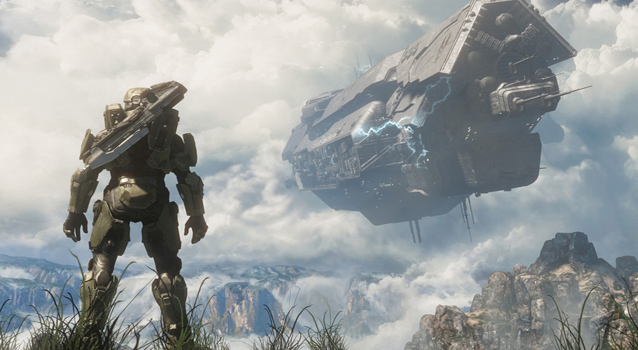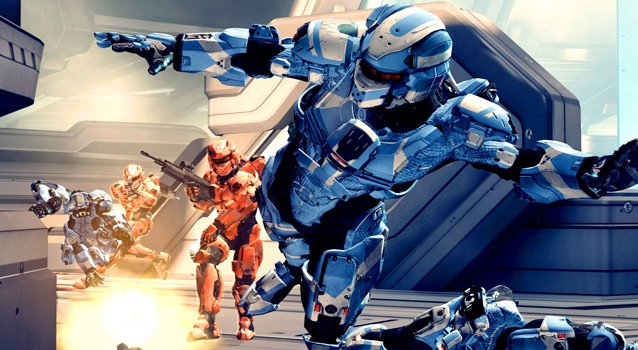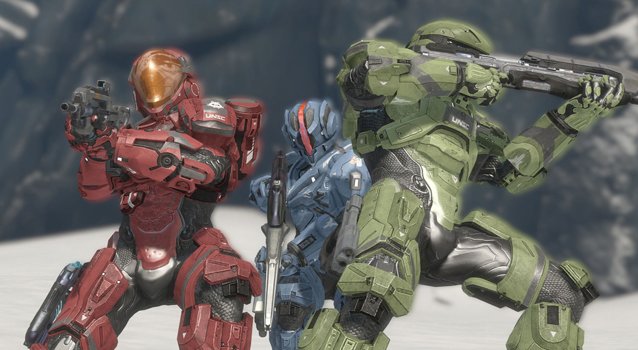


When Bungie departed from the Halo series, it was inevitable that Microsoft would continue the series' development. Instead, the firm gave the reigns of the IP to its internal studio 343 Industries. While there was always the worry that forthcoming Halo titles after Halo Reach would not be showed the same passion Bungie always depicted, 343 Industries has carried out such a commendable job with Halo 4, which marks the first installment in the trilogy dubbed the Reclaimer, that one would be forgiven for not noticing that Bungie were not involved with the title.
Campaign:
Cortana wakes up Master Chief, otherwise known as John-117, after a four year sleep to a wrecked UNSC Forward Unto Dawn, where he discovers the UNSC are at a truce with the Covenant, but not for long. Escaping the ship results in Chief winding up in a new planet littered with a new enemy race called the Prometheans. The majority of the campaign predominately takes place on the Forerunner planet of Requiem.
The plot itself focuses on two fundamental pillars. Firstly, Chief’s purple AI companion Cortana has entered 'rampancy', which marks the death of AI after seven years, while she has been online for eight. Rampancy is when an AI’s processes starts to run out of control, with Chief faced with the task of getting Cortana back on Earth. Of course, that won’t be an easy task for everyone’s favourite helmeted hero.
A variety of Forerunner units delivers a refreshing range of enemies; Crawlers will keep players pinned down, while the Promethean Knights will target you from a distance before teleporting in to finish you off. Suffice to say, without picking one’s targets wisely, expect a considerable amount of ammo to be wasted. The Knights in particular are an interesting and challenging type of an enemy race. Players can take them down from a distance, but you’ll also have to shoot down his accompanying Watcher.
Unfortunately, the majority of your campaign objectives will feel exceedingly familiar -- evacuate a location, defend something, or just make your way to one of the game’s many switches. While it doesn’t necessarily mean the gameplay gets boring, albeit if it may become repetitive, 343 Industries should instill more creativity with the next installment.

Gameplay:
343 has kept the gameplay in their debut Halo title strikingly similar to Halo 4’s predecessors -- although, that’s not necessarily a good aspect. Halo 4’s campaign won’t give you a ‘wow’ moment to deliver the sense that the game’s design has evolved. While some may be comfortable with knowing that nothing too drastic has been implemented and goes by the saying of “why fix something that isn’t broken?”, I’d expect something fresh in a sequel’s campaign component. Although a new plot, new enemy types, new weapons and vehicles may be enough for some, you can’t help but think 343 could have been able to expand beyond tweaking small aspects, especially when you consider the pool of talent the studio has in the form of ex-Bungie employees. That said, there’s still the inevitable excitement that every battle delivers, with action being over-the-top and frantic as it’s ever been.
One of the more notable changes is that sprinting is no longer tied to an Armor Ability. Instead, the game is keeping up with the times and making the feature a default part of the controls. Returning abilities include the likes of the jet pack, active camouflage and hologram. Abilities that are new to the franchise include Promethean Vision, which allows players to have an infrared view of the environment. The Thruster Pack, meanwhile, delivers a quick burst of speed, while Hardlight Shield is a protective shield barrier and Autosentry is a deployable automated turret. Elsewhere, the Regeneration Field produces a short-range healing energy field.
The existence of three factions in Halo 4 means players have a range of weapons to choose from and indeed more than its predecessors. The UNSC boasts the DMR, Battle Riffle, Rocket Launcher, Spartan Laser and Sniper Rifle. A new gun is the 'Railgun', which charges like the Spartan Laser but instead fires a mini explosive. On the Covenant side, the Plasma Rifle has been replaced in name by the 'Storm Rifle'. The Needler, meanwhile, has had its damage capability increased, with needle supercombines capable of targeting multiple enemies.
As for the Forerunner’s weaponry, a whole arsenal is offered. The majority of weapons strike similarities to their UNSC or Covenant counterparts. For example, the 'Suppressor' is effectively a UNSC Assault Rifle, with the Forerunner 'Lightrifle' bearing a resemblance to the Covenant Carbine. Elsewhere, the 'Boltshot' pistol is essentially a revolver, but when charged the weapon discharges four bullets. The Scattershot acts as a shotgun, but its bullets also bounce, allowing players to kill enemies off ceilings, etc.
The majority of vehicles from the Halo series makes a return for both the UNSC and Covenant; expect to see a fair share of Warthog battles and Banshee dogfights. Halo 2’s Elephants, however, has not been included. Instead, Halo 4 introduces 'Mantis', which is a mechanized walker that contains a machine gun with infinite ammo, rockets and a powerful stomp component. The vehicle also boasts a shield, but doesn't deliver jump or sprint abilities so players will be vulnerable if they’re cornered with a slew of enemies.
Playing on the Normal difficulty will take players around seven to eight hours to play through the game’s eight missions. Heroic and Legendary difficulties will of course take longer, but you can still play through the campaign via Halo 4’s four-player co-op online component, as well as playing two-player co-op locally. Regular multiplayer can also be played with four players locally.

Enemies:
When facing Covenant forces, players will encounter the familiar faces of Elites, Jackals, Grunts and Hunters, accompanied by their vehicles such as Ghosts, Banshees and Wraiths. Elites may be one of the more difficult enemies found in Halo Reach, but they're stark in comparison to the new Promethean forces.
Prometheans come in three variants. Promethean Knights are the toughest due to the fact that they dual wield a projectile weapon and a melee weapon. Players will face a tough task in defeating them as they can take a lot of punishment, and also have the ability to teleport around the map, as well as deliver Watchers from their backs.
As for Watchers, these creatures are small but they’re dangerous and you’d be wise in taking them out first. Watchers operate from flying around and can pose a threat with their range attacks, but the real danger is how Watchers can support Prometheans. They can offer a protective shield around allies; resurrect Knights that have just been killed, as well as their their ability to throw back grenades you've thrown at them.
Then there are the Crawlers. They essentially operate as Grunts, but they can climb onto any surface and attack from there. While a clean head shot can kill this enemy type instantly, they’re especially challenging within groups.

Music:
The musical score has been created by Neil Davidge for Halo 4. Audio, of course, has always been an important segment of the Halo franchise, and Martin O'Donnell's legacy is indeed a lot to live up to. Unfortunately, the music is one of the game’s weaker elements. While there are several notable tracks available, the overall score doesn't deliver the same oomph seen in Halo Reach, Combat Evolved or ODST.
That said, the sounds of gunfire are considerably varied due to the amount of weapons available in Halo 4. The voice acting talent of the main characters have returned; Chief is more or less what we’re familiar with, but Cortana’s voice is portrayed in a way where she feels more than just A.I. -- due to the fantastic voice acting and commendable visuals, she feels human and more authentic.

Graphics:
Halo 4 is by far the best looking title in the franchise thus far, and indeed one of the most visually stunning titles on the Xbox 360, which is a surprise what with the end of the current console generation approaching. As well as impressive textures, players will immediately notice the striking facial animations during cut-scenes and lip-syncing during the opening stages of Chief’s new adventure.
Forest locations are absolutely gorgeous, while corridors are suitably dark and dimly lit corridors, which, when combined with neon explosions and gunfire and neon, will make players admire Halo 4’s visuals fidelity. The facial animations, in particular, are admirable. Cortana’s pain can clearly be seen plastered on her face, which ultimately humanises her in a commendable aspect.

Spartan Ops:
Replacing Firefight is Spartan Ops, a co-op story mode that continues to unfold as new free downloadable content packs become available. Spartan Ops focuses on a group of Spartan-IVs exploring the planet Requiem. Each week for the next ten weeks, a new cinematic video that progresses the story after the events of Halo 4’s main campaign is released, as is five new playable levels that lasts around an hour.
The missions themselves are straightforward. Proceed to a point, blow it up, clear the area of enemies and then proceed. As for the five introductory chapters included on the disk, they’re set out over large maps with a considerable amount of vehicular action. Spartan Ops offers persistent waves of enemies, but each mission does come to a close point so it doesn't scratch that itch that made Firefight a worthy mode in previous installments.
The same sense of escalation in difficulty is also missing. Players have infinite re-spawns without losing progress, which makes death practically meaningless so you don’t get the satisfaction of survival. Spartan Ops will need finessing if it is to deliver its potential, so it’ll be intriguing to see how it essentially evolves through fan feedback as 343 create new episodes.

War Games (multiplayer):
Halo 4's multiplayer (now known as Infinity) is undoubtedly the core of the Halo experience in regards to longetivity and play-time. Halo's incredible multiplayer experience is one that has been improved continuously via fan feedback and following a strategy of not fixing something that isn’t broken, with Halo 4 still enforcing that policy. The emphasis in Halo 4’s multiplayer component, now dubbed War Games, has predominately been focused towards tweaking.
One of the more notable changes with the multiplayer, which no longer uses kills to measure the winner of the match and instead bases it off points, is the progression and loadout system. In addition to default loadouts, players now have full control over what primary and secondary weapons, grenades, among others you want within each of your five custom loadout options.
Starting from SR1, players can level up their Spartan Rank as you play in either Spartan Ops or War Games. Each new rank delivers Spartan Points that can be utilized to unlock weapons, Armor Abilities, grenades, Tactical Packages and Support Upgrades. Items such as armor get unlocked for free as players improve. Initial weapons such as the Battle Rifle and DMR are available, with players having to spend Spartan Points in order to add them to your custom class.
Spartan customization still boasts a massive range of cosmetic options, but 343 has also implemented Call of Duty-esque additions. Tactical Packages and Support Upgrade may sound like perks that are in the same vein as Activision's shooter, but they’re differentiated with the fact that Halo 4 doesn’t give players a considerable advantage. Tactical Packages allows you to equip your Spartan with an unlimited sprint ability, faster recharging, carry more grenades, and carry two primary weapons instead of one, among others. Support Upgrades, meanwhile, offers more ammo, improves weapon stability when being fired upon, faster reloading, and more. Elsewhere, Armor Abilities are more Halo-oriented. They include jet packs, boosters, the ability to project a hologram to distract enemies, 'Promethean Vision' that allows players to see nearby enemies through walls and many more. As opposed to just overpowering one’s Spartan, the selection of which perks to utilize should be given some thought in terms of having a tactical advantage.
The majority of the 10 multiplayer maps are new, with a few familiar ones such as Ragnarok, which is a remake of Halo 3’s Valhalla. Weapons, meanwhile, are no longer spread across the terrain as has been in the case in previous Halo iterations. Instead, an ‘ordnance’ system has been integrated where weapons are dropped onto the map throughout the duration of the match. Weapon drops itself will be showcased to players through an indication on their HUD. Players will now be more aware of what weapons have yet to respawn and which ones are available, whilst still maintaining the mentality of rushing towards power weapons. One weapon that does stand out, though, is the SAW. Its accuracy is lethal, as well as the fact that it delivers a healthy proportion of bullets. Never has spraying bullets and killing several enemies in the process felt so satisfying.
The playlist has also been updated, with Halo Reach’s Invasion, a ground war between Spartan and Covenant forces fighting for territory, being removed, as well as the exclusion of Rumble Pit, which mixes several game modes. The flag carrier for Capture the Flag now equips a powerful pistol in the form of the Flagnum. All players can also see where the flag is at all times via the radar. Classic game modes including SWAT, King of the Hill, Grifball, Team Slayer Pro and Oddball all return. The latter in particular now allows players to pass the ball to each other.

New modes include Dominion, which bears a resemblance to Call of Duty’s Domination mode, apart from the fact that it’s much better. Teams have to capture and hold three bases across a map, but players can fortify each base, which provides you with turrets and vehicles to defend one’s position. Joining Dominion is Extraction, where players are required to capture more data points than others. Flood is a fully-fledged version of Infection, while Regicide is a free-for-all/team mode where the player with the most points becomes the king, while killing the king earns more points. Although the king’s location is showcased on the map, you’ll obtain bonus points for kills, as well as bonus player traits such as overshield.
Infinity Slayer, meanwhile, is based off Slayer where two teams are required to work together to earn 600 points (equivalent to 60 kills) for the win. The mode is differentiated, though, through its personal ordnance system, which allows players to trigger a weapon drop that subsequently offers a choice between a new weapon, grenades, or a player trait modifier. In order to call in an ordnance drop, players will have to fill a meter, which can be achieved by killing enemies, supporting your team, achieving double kills, etc.
343 has also showcased another example of how they’re keeping up with the times by allowing players to join a match in progress. You’ll no longer find yourself stuck in a lobby waiting for players to join, but instead chucked into the battlefield where a match has already commenced.
Forge, a toolset allowing players to modify all the multiplayer maps, makes a return with several major improvements. There are now three unique Forge worlds, with each boasting its own distinct look. One of the new tools allows you to create a player trait zone that alters player movement, visibility, shields and damage when situated within the zone. Color-coded highlighting will showcase what you've selected, accompanied by magnets that lines up objects in a more straightforward fashion. Players can also copy and paste assets, as well as being able to lock a set of objects so one doesn't alter something unintentionally.
Theater makes a return, but doesn't feature any major changes from previous installments. Halo Waypoint support is also featured, which allows players to view their Spartan career and stats through their Xbox 360, the web and mobile devices. Also, Waypoint is the only way one can view terminal videos that are hidden in each of the campaign levels.
War Games is enormous fun, which proves that Halo 4 is able to retain its identity of what makes it a gripping and distinctive experience, at least in the online multiplayer department. It makes players think and plan attacks accordingly as opposed to charging against enemies and simply hoping for the best. The customization features also contributes considerably towards a more team-focused multiplayer experience, instilling the urge to work together instead of being a hero by going solo. 343 also toned down the overpowered melee attack in competitive matches. No longer will players divulge into wild gun swinging, but instead a longer recovery time and shorter reach means finishing off an opponent has never been so satisfying.

Halo 4 has implemented subtle tweaks that goes a long way in delivering a blockbuster experience you’d expect from a Halo game. While it’s arguable that isn't the reinvention that many were hoping for, it’s clear that 343 Industries plan to extend their influence on the Halo universe, as stated in a post-script at the end of the game by touting Halo 4 as the first step.
The single player offers the classic Halo point-to-point gameplay, while the marvelous multiplayer, which delivers an experience that oozes addictive quality as opposed to the reliance on stagnant mechanics, integrates a slew of new additions to attract newcomers to the series. 343 has also added a stunning artistic flair to a universe that required a revamp; this is the best looking Halo installment to date and has clearly pushed the Xbox 360 to its upmost limit.
Halo 4 is simply the definition of classic. It's an exemplary personification of what made Halo such a great game, but adds worthwhile additions in the process. While it can’t be promised that fans will adore Halo 4 as one would have seen a lot of it before, Halo fans can rest assured that the series is in safe hands, with 343 sure to affirm its authority and hopefully depict the same ambition the colossal franchise was built on.
4 stars out of 5



